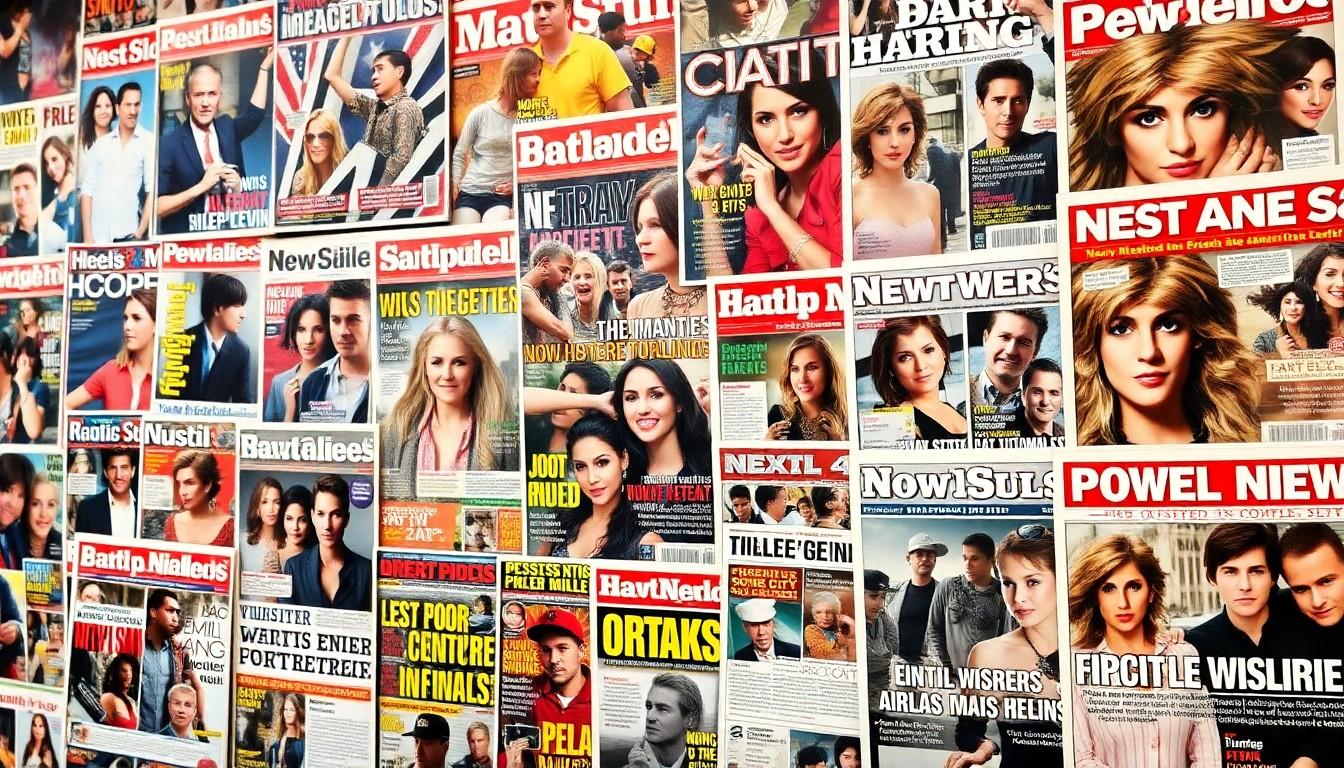
Tabloid Headlines: The Shocking Secrets Behind Their Irresistible Allure
Tabloid headlines are the eye-catching sirens of the media world, luring readers in with promises of scandal and intrigue. Who can resist the allure of a headline that claims aliens abducted a Hollywood star or that a cat has been elected mayor? These outrageous statements not only entertain but also spark curiosity, making them a staple in grocery store checkout lines and online feeds alike.
Tabloid Headlines
Tabloid headlines feature sensationalist language designed to attract attention. These headlines often exaggerate stories, employing eye-catching words that create intrigue. Readers encounter tales of scandal, mystery, and celebrity antics, which keep them coming back for more.
A prominent characteristic of tabloid headlines is their focus on shock value. Claims of outrageous events or dubious situations dominate the content, enticing individuals to explore the details. The headlines serve not only to inform but also to entertain, providing a quick escape from daily life.
In terms of structure, tabloid headlines frequently utilize puns and alliteration. These literary devices enhance memorability and make the stories more engaging. For example, phrases like “Celebrity Caught in Crazy Love Triangle” demonstrate how playful language can enhance reader interest.
Numbers also play a critical role in these headlines. Headlines that include statistics or specific details often increase reader curiosity. Phrases like “Top 10 Unbelievable Conspiracy Theories” effectively draw audiences into exploring the stories behind the claims.
Additionally, tabloid headlines often employ provocative questions. Questions such as “Is This the End of the World?” engage readers and prompt them to seek answers in the accompanying articles. This technique creates a sense of urgency, compelling them to click and read further.
In digital media, tabloid headlines can sway social media shares and engagement. Attention-grabbing headlines that go viral often lead to discussions and debates, amplifying their reach. That’s why every word in the headline counts, as just one catchy phrase can transform a mundane topic into a trending subject.
Characteristics of Tabloid Headlines

Tabloid headlines possess distinct features that capture readership and foster engagement. They rely heavily on sensational elements and straightforward presentation.
Sensationalism
Sensationalism forms the backbone of tabloid headlines. These headlines often employ exaggerated claims and shocking content to provoke emotional responses. Examples like “Aliens Spotted in Rural Kentucky!” illustrate this tactic. Engaging narratives, centered on scandalous relationships or bizarre occurrences, maintain reader interest. By provoking curiosity, such headlines promise entertainment and drama. Therefore, sensational language becomes essential for grabbing attention and encouraging clicks.
Simplicity and Brevity
Simplicity and brevity characterize effective tabloid headlines. Short, catchy phrases create immediate impact, ensuring clarity and memorability. For instance, headlines such as “Starlet’s Secret Scandal!” convey a complete story in just a few words. Clarity matters, as intricate language can lose an audience’s focus. Each word serves a purpose, eliminating unnecessary fluff. Thus, brief and straightforward headlines resonate well, appealing directly to the fast-paced nature of modern media consumption.
The Impact of Tabloid Headlines
Tabloid headlines significantly influence reader dynamics and public perceptions. Their direct approach captivates audiences, compelling them to click or purchase.
On Reader Engagement
Engagement thrives on sensationalism and intrigue found in tabloid headlines. Often, headlines pose provocative questions that spark curiosity. Readers gravitate towards bold claims like “Is This Celebrity’s Marriage on the Rocks?” This element of surprise triggers strong emotional responses. Numbers enhance engagement, as seen in “Top 5 Shocking Celebrity Breakups.” Such figures create an expectation of actionable content, appealing to the reader’s desire for quick information. Overall, tabloid headlines consistently drive engagement through playful language, emotional appeal, and rapid-fire delivery.
On Public Perception
Tabloid headlines shape public opinion and societal narratives. Sensational stories about celebrities or unusual events can cultivate perceptions, whether positive or negative. For example, headlines like “Bizarre UFO Sighting Shocks Town” create a vivid image that sticks in the mind. This phenomenon can lead to widespread interest in unusual topics, shifting cultural conversations. Consistently, readers associate tabloids with entertainment, which enhances their acceptance of exaggerated claims. Ultimately, tabloid headlines contribute significantly to public discourse by influencing what topics gain traction in society.
The Role of Tabloid Headlines in Journalism
Tabloid headlines play a crucial role in shaping journalistic practices. These headlines often use sensationalist language to capture attention. Engaging readers typically occurs through outrageous claims and eye-catching phrases. By focusing on scandalous events, tabloid headlines create a narrative that demands attention.
Clarity and brevity are essential characteristics. Short, sharp phrases ensure readers grasp the message quickly. For instance, a headline like “Starlet’s Secret Scandal!” draws readers in without ambiguity. Simplicity aids in retention, making these headlines memorable.
Numbers enhance the allure further. Headlines featuring statistics, such as “Top 10 Unbelievable Conspiracy Theories,” provide a clear structure that attracts interest. Combining specific details with provocative questions creates urgency, urging readers to click. Phrases like “Is This the End of the World?” compel audiences to seek answers.
Public engagement thrives through these captivating headlines. Tabloid publications often generate discussions and debates based on sensational stories. Such dynamics not only boost readership but also influence public opinion and societal narratives.
Cultivating these perceptions showcases the power of tabloid headlines. For example, a headline like “Bizarre UFO Sighting Shocks Town” ignites curiosity surrounding unusual phenomena. This influence extends into shaping cultural conversations, guiding topics that gain traction in society.
Moreover, the emotional response elicited from these headlines cannot be overlooked. Headlines often provoke excitement and outrage, drawing considerable reader attention. By leveraging sensationalism, tabloid journalism holds a distinct position in media, shaping both discourse and public perceptions.
Sensationalism and Engaging Language
Tabloid headlines wield significant influence in the media landscape. Their ability to captivate readers through sensationalism and engaging language ensures they remain a staple in both print and digital formats. By blending shock value with clarity and brevity, these headlines not only attract attention but also shape public discourse.
As they continue to evolve, tabloid headlines will likely adapt to new media trends while maintaining their core appeal. The ongoing fascination with outrageous stories and provocative questions keeps audiences engaged, proving that the art of the tabloid headline is far from fading.



